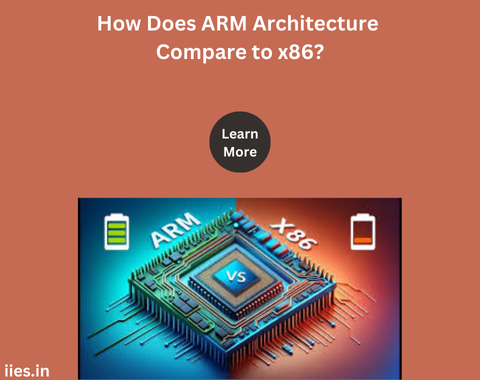
The debate between ARM and x86 architectures has become more prominent as computing needs diversify, particularly with the rise of mobile devices, embedded systems, and cloud computing. ARM (Advanced RISC Machine) and x86 represent two distinct types of processor architectures, each optimized for different workloads and use cases. This article will explore the key differences between ARM and x86 architectures, highlighting their strengths, weaknesses, and typical applications.
At the heart of the difference between ARM and x86 lies the instruction set architecture (ISA) used by each processor family. ARM is based on a Reduced Instruction Set Computer (RISC) architecture, which focuses on simplicity and efficiency. It employs a smaller number of instructions, each of which can execute in a single clock cycle. This simplicity leads to lower power consumption and allows ARM to scale efficiently in various devices, especially mobile and embedded systems.
x86, on the other hand, is based on Complex Instruction Set Computer (CISC) architecture. It includes a broader set of instructions, some of which can perform more complex tasks in a single operation. While this can result in more powerful processing capabilities, it often comes at the cost of increased power consumption and complexity. x86 architecture is widely used in desktop PCs, laptops, and servers due to its strong performance in handling general-purpose computing tasks.
One of the most significant advantages of ARM over x86 is its power efficiency. ARM processors are designed with low power consumption in mind, which is why they dominate the mobile, embedded, and IoT markets. Devices like smartphones, tablets, and wearable technologies benefit from ARM’s ability to deliver sufficient processing power while extending battery life.
x86 processors, while more powerful, tend to consume more power, making them less suitable for power-constrained environments. While Intel and AMD have made strides in improving the energy efficiency of their x86 chips, especially with low-power variants like Intel’s Atom or AMD’s Ryzen Mobile, they still lag behind ARM in applications where energy efficiency is critical.
Performance-wise, x86 architecture has historically had the edge in delivering raw computational power. x86 processors, particularly those from Intel and AMD, are designed to handle complex, heavy-duty tasks, such as high-performance computing, gaming, and content creation. Their complex instruction sets allow them to perform multiple operations per clock cycle, which is advantageous in workloads where performance is paramount.
ARM, while generally lower in raw performance, has made significant strides in recent years. High-end ARM processors, such as Apple’s M1 and M2 chips, demonstrate that ARM can offer competitive performance for personal computing tasks while maintaining excellent power efficiency. These developments challenge the traditional dominance of x86 in desktops and laptops, especially in areas like app performance, video editing, and general productivity.
ARM’s modular and flexible architecture allows it to scale across a wide range of devices, from small embedded systems to powerful supercomputers. This scalability has made ARM popular in mobile devices, embedded systems, and increasingly in server environments. ARM’s ability to be customized by manufacturers for specific tasks also enables companies like Apple and Qualcomm to build optimized processors tailored for their hardware.
x86, while robust in traditional computing environments, is less flexible than ARM in terms of scalability. It is typically confined to personal computers, workstations, and servers. Although x86 chips like Intel’s Xeon series are dominant in enterprise servers and cloud computing, ARM is beginning to make inroads in the data center space due to its energy efficiency and scalability.
ARM has a dominant presence in mobile and embedded markets. With its energy-efficient design, ARM is the backbone of nearly all smartphones, tablets, IoT devices, and embedded systems. The ARM ecosystem is extensive, with companies like Apple, Samsung, and Qualcomm designing custom ARM-based chips for their devices.
x86, however, dominates the desktop and laptop market. Intel and AMD are the primary suppliers of x86 processors, with a well-established ecosystem that includes software, development tools, and hardware manufacturers. Despite ARM’s growing presence in desktops (thanks to Apple’s M1 and M2 chips), x86 still leads in general-purpose computing and remains the go-to choice for gaming PCs, workstations, and servers.
x86 has long held an advantage in terms of software compatibility, particularly with legacy applications. Most commercial software, especially for desktops, is optimized for x86 processors. The x86 architecture’s dominance in PCs over the past few decades has resulted in a massive library of applications, making it the preferred architecture for many industries.
However, the software landscape is shifting. Many applications today are cross-platform, designed to run on both x86 and ARM architectures. With the rise of ARM-based laptops like Apple’s MacBook line, developers are increasingly porting software to ARM. Additionally, the widespread use of ARM in mobile devices has created a large base of ARM-compatible applications.
Recent trends suggest a blurring of lines between ARM and x86. ARM’s increasing performance, especially with chips like the Apple M1/M2 and Qualcomm Snapdragon, has allowed it to compete in spaces once dominated by x86. In data centers, ARM-based servers are starting to offer viable alternatives to x86 servers due to their energy efficiency.
x86, particularly Intel and AMD, remains entrenched in enterprise environments and high-performance computing, but ARM’s rise in consumer devices and cloud infrastructure indicates a shift towards more competition.
The ARM vs. x86 comparison ultimately depends on the specific use case. ARM excels in power efficiency, scalability, and flexibility, making it ideal for mobile devices, embedded systems, and cloud environments. Meanwhile, x86 leads in raw performance, compatibility, and dominance in traditional computing tasks, especially in desktops, laptops, and enterprise servers.
As the technology landscape evolves, ARM is encroaching on territories long dominated by x86, and x86 is adapting to compete in areas like energy efficiency. The future may see an even more diverse array of devices leveraging both architectures based on their respective strengths.
Indian Institute of Embedded Systems – IIES